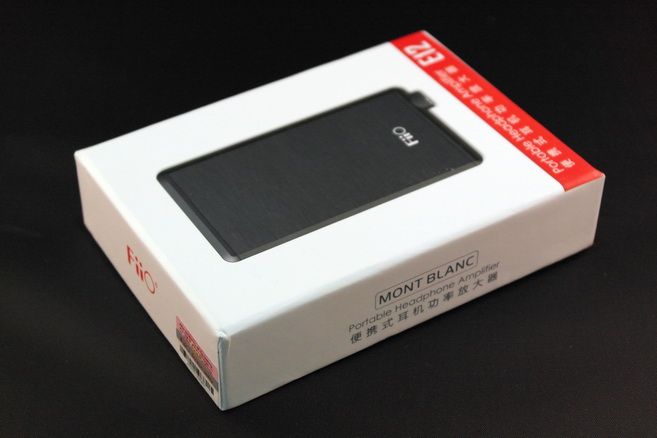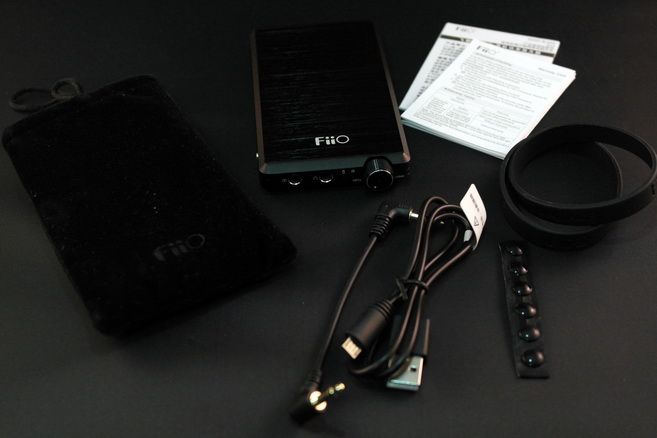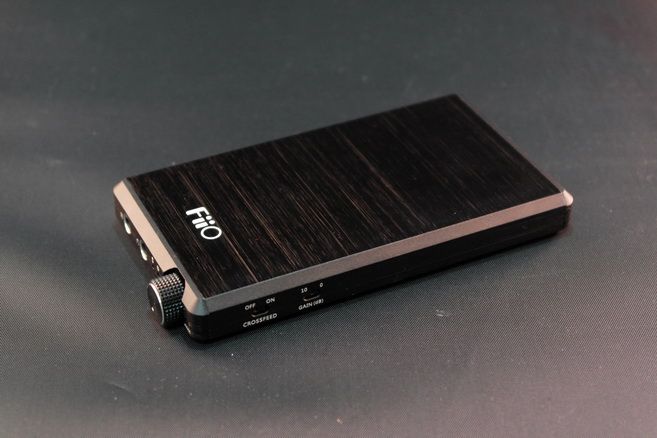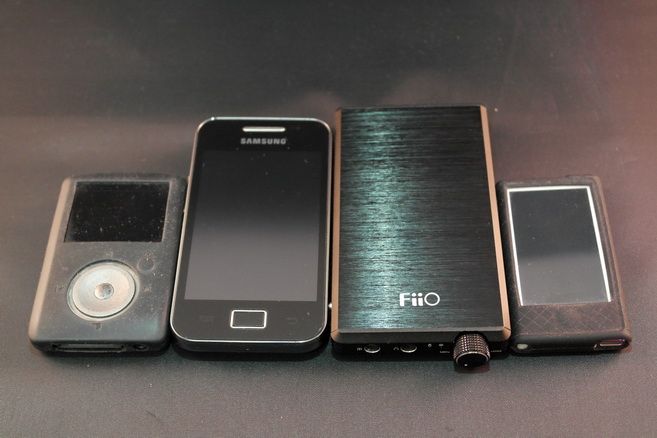However, FiiO decision to develop the E12 as the company first higher end portable amp really looks more like a statement, rather than just trying to break into a new segment of the market. It is to showcase that the company can go beyond entry level products if it wants to, and offers it at a lower price @ US$130 than one would expect of its quality – and perhaps also to answer the demand from some of its audiophile’s fans that want ‘more’.

Spec
Frequency Response: 20Hz – 20kHz
SNR: over 110dB (A weighted)
Crosstalk: over 65dB
Gain: 0dB (low) and 16dB (high)
THD: Less than 0.005%
Max output: 600mW (16ohm), 880mW (32ohm), 160mW (300ohm)
Recommended Headphone Impedance: 16 – 300ohm
Input Impedance: 5kohm
Battery Life: over 12 hours
Recharging Time: less the 3 hours with 5V, 2A.
Selectable Bass EQ and Crossfeed

Packaging, Accessories, and Build Quality
Packaging is pretty much the same style as FiiO previous few models of portable amps, which is basically hard paper box. Accessories are similar as well – two rubber bands, microUSB cable for recharging, a few rubber stick-on feet, a shart 3.5mm interconnecting cable, a soft pouch and the manual.
Build quality is, as always, pretty good. The volume control pot also doubles as on/off switch and it is intentionally made to be stiff and harder to turn so there won’t be any accidental volume change. It will take some getting used to but not a real turn down. Out of the three other switches (bass, crossfeed and gain), crossfeed and gain switches are recessed and not easily adjustable without pointy object at hand. Being recessed is fine, but it would have better if they can be changed without the need of another tool.

Top, with the recessed crossfeed and gain switches on the side.

Bottom with reset hole. Bass switch and microUSB port on the side.

The power LED (blue) and recharging LED indicators are between the headphone-out and volume knob.
Battery Life
The listed battery life is ‘over 12 hours’. It is about right as I have, on two occasions, run the amp continuously for 12 hours and it still has some battery left at the end. Recharging is done with microUSB and any USB port and power adapter should be able to recharge it. However, due to the fact the battery is 11.1V internally instead of the more typical 3.7V, the USB power is internally boosted to 14V during recharging. This means the amp does suck up a lot of power from the USB port. An USB port with higher output will charge it faster, and the speed is reflected on the charging LED indicator. It blinks faster when the USB power supply has higher output and vice versa. Thus it is recommended to use a high output USB adapter to charge the amp if you want to charge it faster.
EMI and Hiss
EMI is quite noticeable on the E12. While far from blasting loud, it is annoying. Also, the amp not only picks up cellphone EMI, but has a tendency to pick up any nearby (within a feet or two) EMI source as well, such as 2.4GHz cordless phone. It probably not going to be great pairing if you are using cellphone as source.
The amp is close to hiss-less in low gain even with some of the most hiss prone IEM. On high gain mode however, hiss become very noticeable. However, any headphone that needs to be used with high gain (16dB!) mode most likely will never be sensitively enough to pick up hiss anyway. So overall it is pretty good in this regard. However, there is also some fainted level of hissing during recharging, most likely a side effect due to the voltage step-up circuit the needed to boost the USB 5V to 14V in order to charge the 11V battery.
All and all, E12 is only doing okay but not great for both.
One interesting feature that you don’t commonly see on many portable amps is the use of a relay to suppress any ‘click and pop’ during startup and shutdown. It is the ‘tic’ sound you will hear after turn on/off the amp. This makes the amp much safer to wear the headphone when turn the amp on / off as there won’t be any big thump sound that could damage the headphone or worst, your hearing.

Size comparison (from left): Sansa Fuze, Galaxy Ace (same size as iPhone), E12, and Nano 7G

Size comparison: UHA-4, O2, C421 and E12
Sound Quality
Despite common belief, higher end amp often isn’t a lot more complex in design. In fact, it can be the opposite sometime. This is because the key to performance is to optimize rather than to complicate. However, amp design is also about compromises – the designer needs to balance between performance, battery life, size and weight, production cost as well as price. Another important perimeter is what kind of load the amp is supposed to drive. While ideally we all love to own just one amp that can behave perfectly in every occasion, the reality is that one that is designed for IEM might not be the best for driving full sized headphone, vise verse. Again, it is another compromise the designer needs to make and the buyer needs to be aware of.
One of E12 design goal is the ability to drive 600ohm full sized (though the spec only lists up to 300ohm), which is quite a tall order compared to the maximum 300ohm load most portable amps are recommended. This means E12 will need to have a lot of voltage swing. This is solved by using a DC-DC circuit to generate a negative rail of 11V so there is a combined swing from +11V to -11V in operation. A side benefit is that it is unlikely you will ever clip the amp with common portable source.
Another goal is that it should be able to drive IEM as well, since it is the mainstream choice in portable world. This means it must have high current output and low impedance. Current wise, my usual test reveal no issue of any kind when driving IEM. The output impedance is so low that it is not measureable by my usual routine. I think it is safe to conclude that it is extremely low and won’t cause any problem driving even the lowest impedance of IEM.
Basic RMAA test doesn’t reveal any issue as well. The FR curve does however show a strange and very mild roll-off in the sub-bass region, starting from 100Hz and reaches -1dB at 20Hz. It is mild enough that I don’t think it will cause much problem audibly. Beyond that, the FR curve is quite flat with a very minor tilt upward that is I think is too subtle for any human to hear.
Subjective listening wise, E12 is undoubtedly a class above your typical sub-$150 portable amp and really pushing itself among the top sounding $200 portable like Leckerton Audio UHA-4, JDS Labs C421 and O2. Good news first – as far as power goes, E12 easily wins out. Control wise, it is also excellent. Even without any bass boost, bass is impactful, solid and very tight. Now comes the bad news – as far as soundstage goes, E12 really loses out. While depth is merely decent, the width feels really narrowed. Overall, the whole presentation seems to get compressed and become rather upfront. Everything seems to be more in-your-face than they should. It is not totally flat, but it is certainly far from being transparent in the overall soundstage, including separation, image and position. As a result of the narrower soundstage, everything feels much more forwarded, which also gives it a slightly edgy and grainy feeling, full of energy and excitement but lack in refinement and resolution. Strange enough it also sounds thicker, richer and more euphonic in the mid without getting congested. It gives the same feeling of listening to old RSA amp or Headamp Pico, where warm is the dominating characteristic. It will be a sound that, I think, goes well with full size that has really wide soundstage or generally being regarded as more laidback (kind of a ‘complimenting’ effect there). Probably not the best pairing for IEM which are usually more upfront / close-in since it can get a bit too much. It is not to say it will sound bad, but certainly not going to be particular great synergy wise. Due to this hindering of transparency, I’ll rate E12 almost on par with C421-OPA2227, and just below UHA-4, C421-AD8620 and O2.

EQ
The bass EQ is basically a sub-bass boost in my review unit (first batch). It starts just under 200Hz and peaks around 25Hz @ 4dB. Due to feedback from the first batch, FiiO has decided to move the boost a bit forward in the frequency so the next / current batch will have a broader boost and peak closer to 70Hz. As far as how much / wide a bass boost should be, it is all about personal preference. I like the sub-bass boost because it adds really solid rumble to the music without adding much coloration into the overall sound, but a broader bass boost can be beneficial if you also want to add warmth to the music.
Another feature that is a first for FiiO is the implementation of crossfeed. If you don't know what it is - it is intentionally leaking just a small amount of left channel to the right and right to the left with a tiny bit of delay. The theory is that, human don't listen music in true stereo in open space so it will be more relaxing and natural to have both channels mixing a little bit into each others. While the theory is good, it is often also a personal preference on whether individual will find it better. Some find it great, some, including me, don't find it any particularly useful.
Ending
E12 is a portable amp that FiiO can be proud of. It still lacks the total transparency and complete effortlessness to be that top-of-the-top amp, but it is getting really close. By far the best sounding FiiO yet, it also a testament to FiiO steady improvement over each generation of portable amps they manufactured. Perhaps it won’t be too long that we will see a FiiO portable that is not just challenging the top level portable, but capable of dominating them as well. Full transparency is never a strong point of FiiO, it is however the last step they will need to conquer before reaching the pinnacle of their craft.





